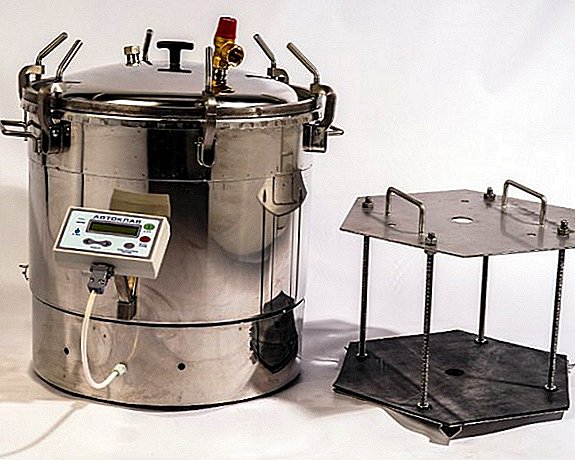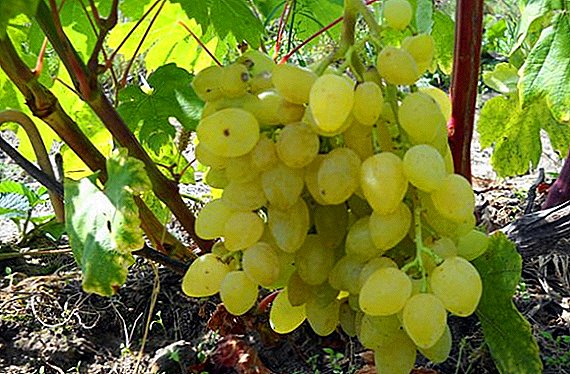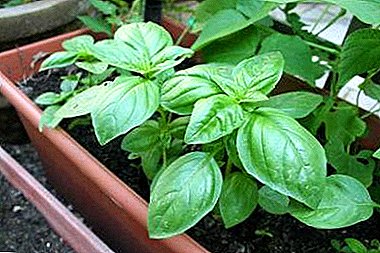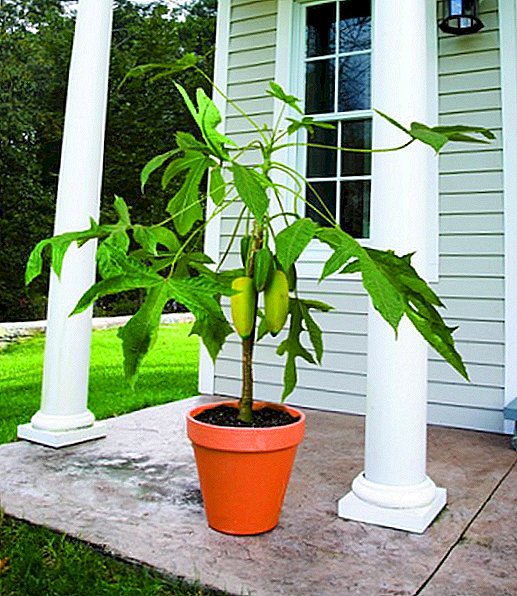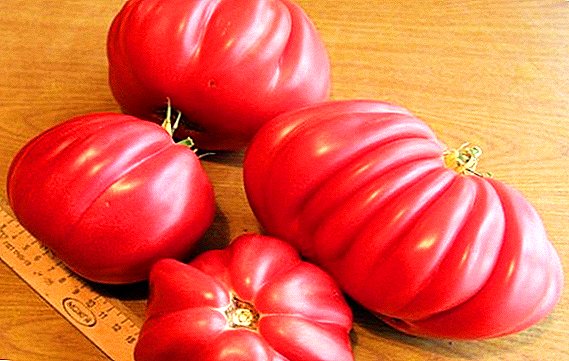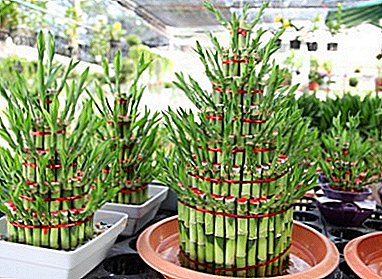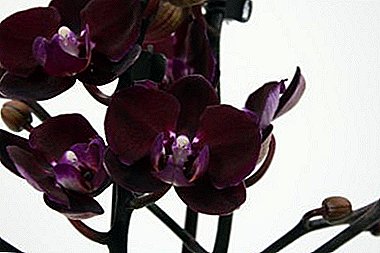
Orchid variety Kaoda is considered one of the young species of this plant. However, despite its short existence in the world of orchids, Kaoda has already a sufficient number of subspecies, every year new species appear.
This article will discuss the features of care, reproduction, as well as how to deal with diseases and pests on the orchid.
Brief Definition
By its origin, Kaoda is a hybrid, obtained due to the long diligence of breeders. By nature, this plant grows in mountain ravines or in tropical forests.
Detailed description
 The second name of this variety is “black orchid”. However, this name does not match the actual color of the plant. Such a "black" effect is achieved due to the saturation of burgundy, purple and beet flowers. The petals are distinguished by high density, saturated with wax, so they seem to shine and shimmer in the light.
The second name of this variety is “black orchid”. However, this name does not match the actual color of the plant. Such a "black" effect is achieved due to the saturation of burgundy, purple and beet flowers. The petals are distinguished by high density, saturated with wax, so they seem to shine and shimmer in the light.
The height of this orchid is considered medium - the stem can grow up to 0.2 meters and usually this stem is completely hidden by leaf plates. The leaves, in turn, can reach 22 centimeters in length, and in width - 8-10 centimeters. The shade of the leaf plates is very rich, thick, dark green. Sometimes the leaves may be smaller in size, but usually this happens in young plants.
Flower arrow grows from a leaf outlet. Sometimes the peduncle is branched. In most cases, Kaoda has two flower stalks. On one such arrow, up to a dozen flowers may bloom, with proper care, there may be fifteen buds. The diameter of the flowers - 4-5 centimeters.
The buds have petals of regular shape, beet or purple. In some cases, there are petals with white border. The lip is white, in rare cases with violet patches. At the end of the lip forks.
Kaoda is notable for its magnificent light aroma. But you can smell it only at lunchtime.
History of
According to botanists, an orchid in nature was discovered several centuries ago. This was done by Professor Karl Brumah. Then, at night, these flowers seemed to him butterflies. Hence the origin of the name.
It was possible to adapt an orchid to home cultivation only a couple of decades ago. In turn, it is Kaoda is no longer a natural orchid variety, but the result of a long work of breeders in crossing existing species.
What is the difference from other species?
The main distinguishing feature is the color of the petals. But flowers are also distinguished by their structure: density, gloss and fleshy.
Sub with photo
We describe the two most common types of orchids, Caoda.
Chocolate drops

This type is translated as drops of chocolate. The plant has earned its popularity due to the very pronounced aroma and shade. The petals have a dark purple hue, the flower itself reaches 5-7 centimeters in diameter. And the sheet plates are not very large - only 15 centimeters in length, but at the same time strong and elastic.
Twinkle

From foreign this name is translated as "flicker." The shade of flowers is also very bright and saturated, but already burgundy in color. The stem can grow to 20 centimeters, and the leaves a little more - up to 22-25 cm. This sub-grade has no bright aroma.
The video shows an overview of the variety Caeda Twinkle:
Bloom
Period and duration
As already mentioned, Kaoda can dissolve the buds at any time of the year. Moreover, flowering usually continues for a long time. Often in the spring begins the growth of buds and flower stalks.
Tip! During flowering, orchids are practically not fertilized.
Conditions of detention
Before the first flowers appear, the care of Kaoda should be standard (we will describe it below). But after flowering you need to trim the floral arrows. This should be done only after it dries completely.
If necessary, you can transplant the plant. And also give him at least a half-month rest. At this time, watering is reduced to a minimum, and fertilizers are not applied at all.
What if there are no buds?
Caoda is a very capricious plant in relation to its temperature. It requires a lot of heat. In summer, the temperature of the content should vary between 25-33 degrees above zero. And in the winter - 16-21 degrees of heat. Do not forget about the daily temperature drops. The difference should be about 3-5 degrees.
In spite of the fact that this variety can bloom constantly, it is better to arrange a monthly rest for the plant at least once a year. At this time, Kaoda will gain strength for the new bloom.
Care instructions
Choosing a place
Here it is necessary to base on two principles: lighting and ventilation. As for the light, it is better to give preference to the eastern or western sides of the room. If we talk about airing, it is important to ensure that fresh air does not turn into a draft. From it the plants can start to hurt.
Soil preparation and pot
 The pot should be chosen transparent, with a small diameter - about 15 centimeters. The container should be transparent to allow the root system to participate in the process of photosynthesis. It is recommended to purchase a pot with smooth walls. Otherwise, otherwise the roots will grow into the surface of the pot.
The pot should be chosen transparent, with a small diameter - about 15 centimeters. The container should be transparent to allow the root system to participate in the process of photosynthesis. It is recommended to purchase a pot with smooth walls. Otherwise, otherwise the roots will grow into the surface of the pot.
The soil is better to buy ready-made, designed specifically for the Orchid family. But if the florist wants to prepare the substrate by himself, he will need the following components:
- sphagnum moss;
- bark (better than pine);
- river sand;
- peat.
All this must be mixed in equal proportions.
Important! Do not forget also about the drainage layer, which prevents the stagnation of water.
Temperature
In the summer, you need to provide a temperature of 26-31 degrees Celsius. and in winter, the degrees can be reduced to 16-22.
Do not try to warm the orchid with heaters. Thus, the air around and the plant itself will simply begin to dry.
Humidity
Since the birthplace of this plant is rainforests, the air around the flower should be well moistened. This can be done by simply spraying both Koda herself and the space around her. But sprinkling the plant, it is important to ensure that water droplets do not fall on the buds and leaf rosettes.
Another way to provide moist air is to put a container with water near the flower.
Lighting
 Any member of the orchid family loves a lot of light. This should be taken care of first. But in the hours of the hot scorching sun, fleshy green sheets should be hidden from the burning rays. But you can not rearrange the plant. You just need to hang the window with reflective foil or just a sheet of paper.
Any member of the orchid family loves a lot of light. This should be taken care of first. But in the hours of the hot scorching sun, fleshy green sheets should be hidden from the burning rays. But you can not rearrange the plant. You just need to hang the window with reflective foil or just a sheet of paper.
In winter, you will most likely have to resort to artificial lighting.to ensure Kaode at least 10 hours of light per day.
Watering
Soil moistening directly depends on growing conditions. Need to focus on the color of the roots and the condition of the soil. The root system in dry form has a silver-gray tint. A substrate should stand dry for at least several days.
Top dressing
It is recommended to make additional food twice a month. But it is allowed to do this only during the period of active growth of the development of the orchid. At the time of flowering Kaod does not need any additional feeding. Since such manipulation can lead to the fall of the buds and reduce the flowering period.
For additional nutrition, it is better to use complex fertilizers intended for Orchids. In such complexes, all nutritional elements are fully balanced.
Transfer
This is usually done every two to three years. The reason for changing the pot becomes clogging of the soil and the size of the root system. If the roots become cramped in the old "house", you do not need to pick a pot much more than the former. It is enough to increase the diameter of the pot by a couple of centimeters.
How to multiply?
 The easiest way to get another orchid at home is to seed the baby.
The easiest way to get another orchid at home is to seed the baby.
To separate the process, you need to wait until it has good roots and a few leaves. Baby care is the same as for an adult plant.
Inventory for separation of the process from the peduncle should be well sharpened and disinfected.
Diseases and pests
For Koda, the most dangerous parasite is the spider mite. It is possible to get rid of it with the help of acaricidal treatment (the safest fitoderm). The treatment is carried out several times with an interval of one week.
Very often, the orchid may be subject to decay. And any site can rot. plants. Such a process occurs due to too abundant watering or cold air around. After the discovery of decay, you need to transplant Kaoda, cut off all the affected areas and change the conditions of detention to the optimum.
Kaoda Orchid is a variety that has become more adapted to cultivation in our conditions. Therefore, if you follow all the rules, the florist will constantly enjoy the beauty of this plant.


